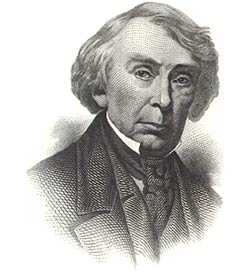 |
 |
| Chief Justice Roger Taney |
| Biography: |
| Taney Court: |
| Major Cases: Charles River Bridge v. Warren Bridge 1837 New York v. Miln 1837 Luther v. Borden 1849 Scott v. Sandford 1857 (Epstein, 2001) |
| 5th Chief Justice of the United States Supreme Court |
| Born: March 17, 1777 in Clavert County, Maryland Died: October 12, 1864 in Washington D.C. Education: 1795 Dickinson College 1799 admitted to the bar Employment: 1799-1800 member of the Maryland State Legislature 1801-1823 private pactice in Frederick, Maryland 1810-1815 director of the State Bank Branch in Frederick, Maryland 1816-1821 member of the Maryland State Senate 1818-1823 director of the Frederick County Bank 1823-1831 private practice in Baltimore, Maryland 1831 acting United States Secretary of War 1831-1833 attorney General of the United States 1833-1834 United States Secretary of the Treasury 1835-1864 appointed Chief Justice of the United States Supreme Court by President Jackson 1864 died in office (Virtualology, 2002) |
| Chief Justice Taney started the Taney and Civil War Court Era. Which followed the extraordinary court of Marshall. Taney had to prove himself to be just as good if not better than Marshall because Marshall was seen as the �Greatest Chief Justice�. (Choper, 1987) His Court�s focus was to increase federal power or state power. It was a difficult time for the Courts during this time era because there were members from the south and the north, which split the court, and it was up to Taney and the two other justices that followed to make sure that the Court didn�t divide too much because they didn�t want to loose the power the Court had.(1987) His first case Holmes v. Jennison, had to do with extradition between the United States and other foreign countries. (1987) According to Taney it is the United States discretion whether or not we wish to acknowledge the requests of foreign countries. Homes lead to the extradition between states. In the state extradition the state that is holding the said person can either try the person, if the crime is greater than the other state, and then when that person is done serving their time they will go to the other state and be tried for the crime that might have been committed in that state or if the said person didn�t commit a crime in the state that he is in but did in another the state then the state can send him over to be tried in the state where the crime was committed. (1987) Extradition was a major factor in the Timothy McVay case. One hand people wanted him tried in a state that supported capital punishment and then there was the group that didn�t. He was tried in a state that favored capital punishment. The Dred Scott decision was a major influence in American life and on the Court. It said that if a person was a descendent of an African American slave then the person could not be a citizen of the United States. (Glendon, 1999) This case helped develop the Jim Crow Laws that stagnated the American way of life as well as the Supreme Court. After his decision he suffered assaults on his judicial actions and his character even came into question. (Choper, 1987) The court cases that followed showed how great a Chief Justice Taney was but because of Dred Scott he would never regain the standing that he once had and he died a hollow man. (1987) |